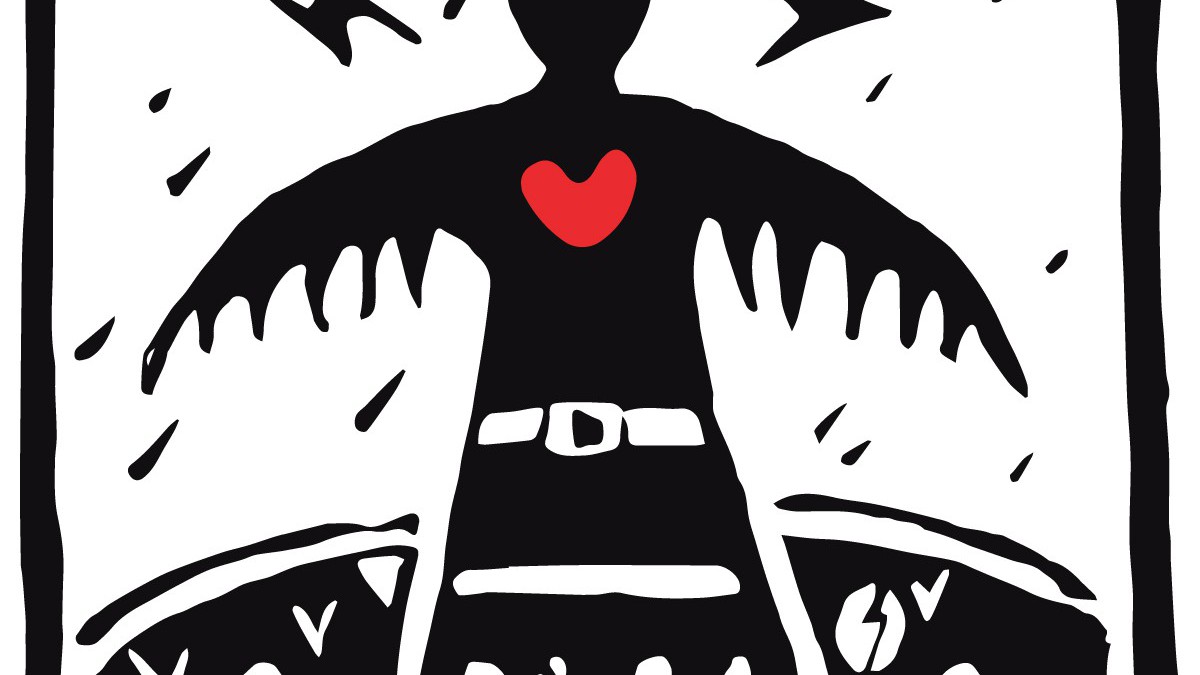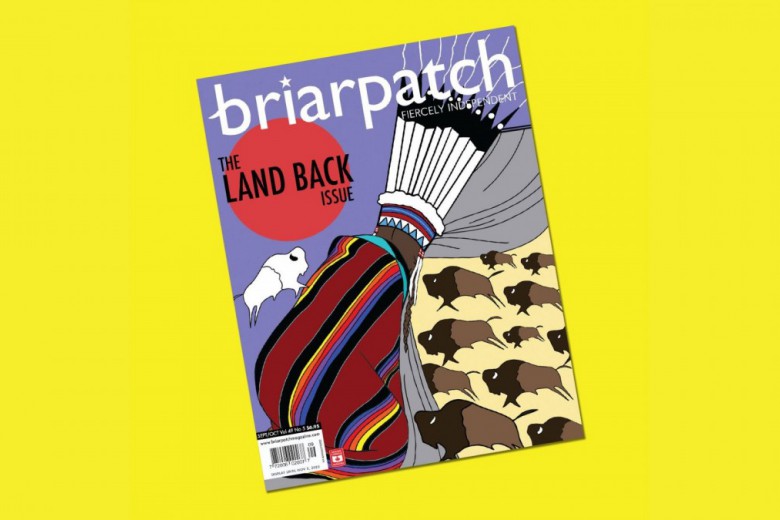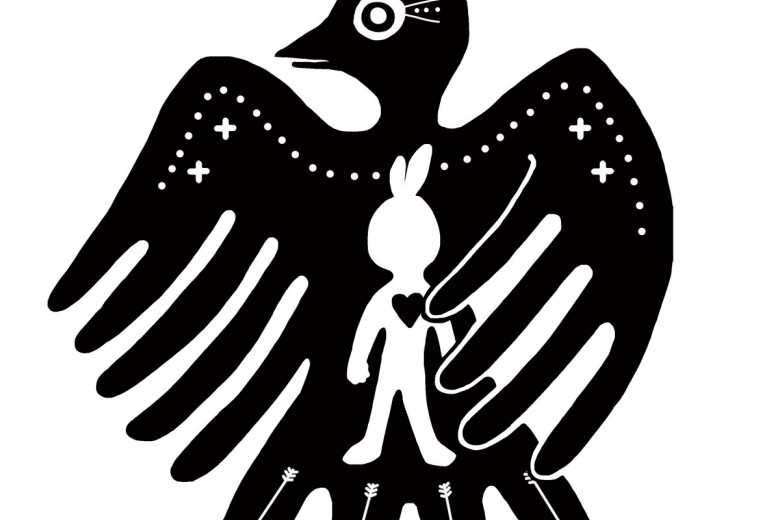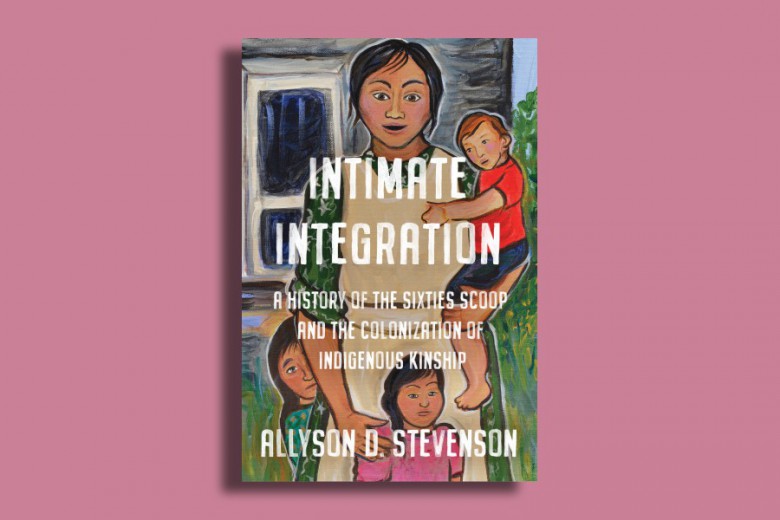The first time I met my grandmother, she was crowded into my tiny apartment with a group of Anishinaabe mothers and grandmothers, each family involved in a battle with Ontario’s Children’s Aid Societies (CAS). She wasn’t my grandmother yet – the adoption came later, after her family began to heal from their ordeal. I had been invited to join the group as a writer – a friend struggling with her own CAS case asked me to help them generate media attention. My adoptive grandparents know all too well how important it is to have family that’s close, and they invited me into their family when they learned that my own family lives far away. As a white woman, I remain an outsider to Anishinaabe laws and traditions, albeit a well-informed one. But I am also someone whose family is on the line.
At the first meeting of our group, which would come to be called “Anishinaabe Families Talk Back,” my grandma barely said two words. I found out later that this was uncharacteristic of her. But with her great-grandson in foster care, torn from her arms some months earlier by a team of police and CAS workers, she couldn’t risk speaking up. It’s common knowledge among families involved with CAS that any sign of frustration or anger is enough to get one labelled “aggressive”; my grandfather has a note in his police file to that effect, from the day they took his great-grandson away. Others at the meeting spoke for those who were scared into silence: this isn’t fair, it hurts so much, I don’t know what to do, I thought the Indigenous agencies were supposed to make this better.
Indigenous children account for about eight per cent of Canadian children below the age of 14, but make up over half the number of children in foster care. Ontario’s numbers are consistent with the national problem. Although Indigenous children represent only 4.1 per cent of children under 15 in Ontario, they make up 30 per cent of the children in foster care.
Others at the meeting spoke for those who were scared into silence: this isn’t fair, it hurts so much, I don’t know what to do, I thought the Indigenous agencies were supposed to make this better.
Indigenous child welfare agencies have existed for decades. Originally, they acted as advocates for Indigenous families involved with colonial Children’s Aid Societies. Changes to the Ontario child welfare system in 2017 mandated that the province’s jurisdiction over Indigenous children would be assigned to the agencies belonging to their nations. This change was supposed to put the well-being of Indigenous children back into Indigenous hands. In early 2018, 105 of these agencies across the country were promised government funding for programs to keep families together. The funding commitment came after the Canadian Human Rights Tribunal ordered Ottawa to end the discrimination that sees it providing less money for services on reserves than elsewhere in the country, a system that incentivizes child apprehension.
But families involved with these agencies say that nothing has changed. “Indigenization” is purported to provide better access to culture, but workers are often white, and a pan-Indigenous approach is often taken instead of a culturally specific approach. For example, families that do not smudge have been instructed to deal with disputes and negative emotions by smudging; Elders in the Anishinaabe Families Talk Back group have reported being disrespected in the agencies and even in their own homes; co-sleeping (a common practice in Indigenous families) is still forbidden by many workers and agencies; and children are disciplined more harshly than Indigenous customs allow. Some urban Indigenous families in the Sudbury area told Anishinaabe Families Talk Back that their children were required to be in foster care on their reserves, meaning the children were moved hundreds of kilometres from home. The superficial trappings of culture, such as Indigenous-sounding names for practices and procedures (think supervisory meetings now being called “sharing circles”), take the place of policies that would grant jurisdiction over Indigenous children to Indigenous families, individuals, and communities.
The superficial trappings of culture take the place of policies that would grant jurisdiction over Indigenous children to Indigenous families, individuals, and communities.
Indigenous children have been stolen from their families for generations, in a pattern of oppression that started with the Indian Act and continued through the reserve system, residential schools, the ’60s Scoop, and colonial Children’s Aid Societies. A second wave of child apprehensions over the last three decades has been called the Millennium Scoop. As a result of the Millennium Scoop, there are more Indigenous children in foster care today than in the residential school system at the height of its operation. To break the pattern, Indigenous families must have direct control over child welfare policies and practices. Activists across the country are building up their traditional systems so they can do just that.
Five generations of resistance
Interfering with Indigenous family structures has been a part of the colonial agenda since day one. As Anishinaabe artist and activist Isaac Murdoch explains, the Canadian government’s “Indian problem” was “free-roaming Indigenous people.” The point of the Indian Act, the reserve system, and residential schools was to phase out Indigenous citizenship over time, to free Indigenous land for resource extraction, and to make sure Indigenous children and their families would never repopulate the land. According to Isaac, making Indigenous people rely on government and charitable services instead of their own hunting, gathering, and familial and community practices wasn’t a kindness designed to ameliorate the harmful effects of colonization. It was a part of the plan. The colonial state’s goal – to “kill the Indian in the child” – wasn’t a metaphor. It was genocide.
The Anishinaabe Families Talk Back group knows that the child welfare system has engaged in continuous violence against their nations since colonization began. Some have been involved with CAS and its predecessors for four or five generations, as stolen children, as parents under investigation, or as guardians to family members’ children. Misty*, a great-grandmother, remembers being sent to residential school in 1955, at seven years old. Her father, who was also a residential school survivor and had hoped to protect her from abuse, told her not to let them see her cry. But Misty remembers the sound at night of dozens of girls crying in the dormitory. Sometimes they would crawl under the partitions and climb into bed with her so she could hold them while they sobbed.
Misty’s husband, Rob*, never went to residential school – when the Indian agent came, his parents sent him to hide in a shed. But he lost his brothers that day, and although he was allowed to grow up at home in Wiikwemkoong Unceded Territory on Manitoulin Island, he was preyed upon by George Epoch, a Catholic priest who is now infamous for sexually abusing hundreds of boys, many of whom were Indigenous, and most of whom were poor or fleeing violence at home. To this day, Rob is angry to know that Epoch is buried beside his parents on Manitoulin Island.
Some have been involved with CAS and its predecessors for four or five generations, as stolen children, as parents under investigation, or as guardians to family members’ children.
As some residential schools were closed between the 1950s and 1980s, Indigenous children became the victims of the ’60s Scoop, which was the systematic targeting of First Nations and Métis families for child welfare interventions, in which Indigenous children were removed from their homes and adopted into white families. Debbie Lemieux, a tireless Indigenous child and family advocate in and around the Sudbury area, was one such victim. She was two years old when she was taken from her family in Temagami First Nation – one of her earliest memories is of being adopted, of the panic and confusion that she felt. Her adoptive family was often abusive, and she wasn’t raised in her culture, so she was forced to relearn it as an adult.
The displacement that began with residential schools has continued through the ’60s Scoop to this day. Rachel* was taken from her family as a child, a victim of the Millennium Scoop. Her mother, an Indian day school survivor, struggled with substance use disorders and mental health challenges. Her brother, Tim*, was also taken from the home by CAS. Both had gone through serious mental illness, suicide attempts, and substance use disorders by the time they aged out of foster care. And when they had their own children, they too were taken by CAS.
Rachel’s daughter, Jess*, was apprehended as a toddler; Jess’s infant brother was taken at the same time. Like Debbie, Jess says her apprehension is one of her earliest memories. Rachel put everything she had into recovery from her mental illnesses and substance use disorder, and she eventually regained custody of her children. “I felt as though I had broken a cycle,” Rachel says. “One of my biggest motivators was that I did not want a life for my kids like the one my brother and I had.” Determined to help other families break their cycles of trauma and separation, Rachel studied Indigenous social work at Laurentian University and went to work in mental health and harm reduction services.
Today, Jess is 16, living at home with her mother and brother, and her mental health is stable. But this outcome came at an enormous cost. When Jess began to experience psychosis in her teens, Rachel was forced to make a difficult choice: forgo the expensive mental health treatment Jess needed, or sign away her parental rights, so the child welfare system could pay for treatment. It took a year and a half for Jess to get into residential treatment after Rachel surrendered her to care. In that time, Jess was transferred from foster home to group home to group home; she racked up criminal charges, she began using substances, and she was sexually assaulted.
Rachel was forced to make a difficult choice: forgo the expensive mental health treatment Jess needed, or sign away her parental rights, so the child welfare system could pay for treatment.
Like his sister Rachel, Tim began treatment for substance use and mental health issues when his daughter was taken away. Today, he is an outspoken advocate for Anishinaabe traditional medicine and for the potential every Indigenous person has to heal and live a good life. He practises traditional storytelling, and he shares his experiences with audiences across Ontario. Yet his daughter, Darlene*, remains in foster care. Wiikwemkoong First Nation child welfare cases are now handled by a provincially mandated Indigenous agency called Kina Gbezhgomi Child and Family Services. It’s an agency that once acted as an advocate for families, but little about child welfare practices has changed since Tim was a foster kid. Tim has fought for months for greater access to his daughter, with little success, often because his frustration is framed as “aggression.” He has supervised visits, with Rachel watching over the family. A bid by the family to have Darlene moved from foster care to Rachel’s home was denied based on Jess’s mental health and criminal record.
Fighting to win
Isaac explains that while good people get into social work, hoping to help, the education system only covers a colonial point of view, colonial laws, and colonial policies and standards. The post-secondary system isn’t set up to teach Indigenous culture and traditions to students, and most social work students and professors in Canada are white and have no personal experience of Indigenous ways of life. Because Indigenous laws are based on observations of the land and its inhabitants, it’s difficult to write textbooks, or even policies, instructing future CAS workers on how to offer culturally appropriate services. And what’s appropriate varies from nation to nation, even within common language groups such as the Anishinaabeg.
Some workers have opposed these colonial practices, both from within the child welfare agencies and from other positions in Indigenous governments. Debbie was one such advocate until very recently. While employed as a band representative at Wahnapitae First Nation for more than 10 years, Debbie advocated against separation on behalf of about 100 families. When families from surrounding First Nations reported that their band representatives were unhelpful, chastising the families and backing CAS, Debbie took their cases on, unpaid and in addition to her regular workload.
Seeking an empowering quote from Debbie’s family, I asked her young adult son what she’s like and what her work means to him. “She’s a nerd,” he answered, laughing. And he’s not entirely off base. Debbie comes to Anishinaabe Families Talk Back meetings armed with massive binders. She always keeps a copy of the Child and Family Services Act handy, even though she can quote its policies from memory. She carries typed reports of “her” families’ experiences, and the emotional weight of someone who sits with people at what is usually one of the worst times in their lives. She’s been successful in reuniting dozens of families, and in helping others to access more visitations, and financial and social resources such as temporary care allowances, culturally appropriate daycare, and specialized health care.
Because Indigenous laws are based on observations of the land and its inhabitants, it’s difficult to write textbooks, or even policies, instructing future CAS workers on how to offer culturally appropriate services.
Thanks to Debbie’s advocacy, Misty and Rob saw their great-grandson returned to their home only three months after he was taken. When children are apprehended, their guardians are often overwhelmed by the paperwork, parenting classes, allegations, court dates, and meetings that CAS requires of them. CAS offers little or no information about its policies or families’ rights. Allegations against families are often outright lies: Misty, who takes medication for chronic pain, was accused of having a drug addiction. A child welfare worker asked Misty’s granddaughter how she feels “when your grandmother is under the influence.” Engaging with CAS can be humiliating, terrifying, and infuriating, but families worry that standing up for themselves will make things worse. Knowing the policies, challenging the lies, demanding respect, and speaking up for families is where Debbie came in.
Debbie called an Anishinaabe Families Talk Back meeting in the summer of 2018, and when we arrived on her sunny back deck, we found her clearly distraught. A meeting had taken place between Debbie’s boss at Wahnapitae and representatives of mandated child welfare agencies who felt threatened by her work. “They felt threatened by my knowledge of the new [Anishinaabek Nation] Child Well-Being Law,” she said. She expected to be fired. “They told me I was hurting the families. I was too loud, too argumentative. It was getting more children taken away,” she told us, and the pain and shame she was feeling were audible in her voice, louder than the words themselves. After losing her job, Debbie turned to her traditional practices for support. She visited my grandparents, and they gave her teachings and supplies for a fast and vision quest in the woods. After four days, she came home with a vision. Paid or not, her path was to fight for Indigenous families caught in the Children’s Aid system, and she was going to win.
Treating children as sacred
Although federal funding for Indigenous CAS agencies has recently increased, a patchwork funding and jurisdictional system has contributed to ongoing colonial dominance in the Indigenous child welfare system. Agencies on reserves and in the Yukon are federally funded, while off-reserve agencies serving Indigenous people are provincially funded. However, jurisdiction for on-reserve agencies is typically delegated through provinces, which fund the agencies and seek reimbursement from the federal government. Some on-reserve agencies are integrated with provincial services to care for children off reserve as well, but others are not. All Indigenous agencies are required to follow provincial policies, except in Saskatchewan, where the Indian Child Welfare and Family Support Act, developed by the Federation of Saskatchewan Indian Nations in the ’90s, is considered equivalent to provincial policies.
Self-government is what Indigenous activists say will resolve the crisis. But only very rarely has a self-government model been implemented in Canada.
Now, that’s seemingly poised to change. At the end of November, the federal government announced plans to hand over control of child welfare services to Indigenous governments. But the specifics are still unclear, and the legislation still needs to be passed. Indigenous nations have a right to be wary, since settler governments have often reneged on promises to relinquish control.
Isaac emphasizes that the system we have today wasn’t created by accident. “This was planned,” he argues. “The plan is working.”
Indigenous nations have a right to be wary, since settler governments have often reneged on promises to relinquish control.
Isaac argues that Indigenous people and allies need to see that land claims, child welfare issues, and resource extraction are not separate issues. They all align to ensure the Canadian state can extract as much profit as possible from Indigenous territory while facing the least resistance possible. No matter what the federal government’s new legislation looks like, it’s unlikely to fund the traditional and self-governed initiatives that grassroots movements are already implementing without settler government support. If there is funding, says Isaac, it will be used to build up the colonial system, as it trickles down to the Indigenous child welfare agencies already co-opted by colonial policy. The only solution is for families and communities to get Indigenous youth and children out on the land, learning the natural laws that inform Indigenous culture and laws. Too much energy is wasted on tearing down CAS, which isn’t going to go away. Instead, Indigenous nations need to build their own capacity to do child welfare themselves.
Through public education and mutual aid, groups like Anishinaabe Families Talk Back and the Justice for our Stolen Children protest camps that appeared in multiple cities last winter are trying to do just that – whether the colonial state is ready for their intervention or not. In practice, this means doing a lot of advocacy that typically goes unnoticed.
Debbie and Isaac say there’s no flowchart for how a child welfare case would go under Anishinaabe law because each case is unique. Speaking generally, they say that if someone saw children in danger, they would meet with their clan (extended family and related families), who would arrange either to support the parents or to care for the children while helping the parent learn to take care of them. If more resources were needed, then they would appeal to one of the six other primary clans – since a person doesn’t change clans when they marry, each parent would have a clan to offer support. The entire process would be rooted in ceremony and guided by the advice of grandmothers. Treating children as sacred is the first step toward solving the interconnected problems of environmental destruction, economic inequality, and family separations.
The ideal child welfare system, says Isaac, would recognize that it’s about more than keeping families together. It’s about finding identity, producing a new generation of climate leaders and water protectors, and rebuilding Indigenous governments and family systems.
As Isaac puts it, “We need a fucking revolution.”
*Names have been changed







